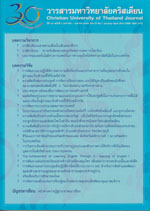ผลการฝึกเดินบนสายพานเลื่อนในเด็กสมองพิการ
บทคัดย่อ
เด็กสมองพิการ เป็นกลุ่มอาการที่มีความผิดปกติเกี่ยวกับการเคลื่อนไหว เกิดขึ้นในเด็กที่มีเนื้อสมองถูกทำลายก่อนที่จะพัฒนาเจริญเติบโตเต็มที่ ซึ่งการทำลายเนื้อสมองนั้นมีผลกระทบต่อระบบการเคลื่อนไหว ทำให้กล้ามเนื้อทำงานไม่ประสานสัมพันธ์กัน การทรงตัวหรือการทรงท่าผิดปกติ หรือมีรูปแบบการเคลื่อนไหวที่ผิดปกติ ส่งผลให้เด็กมีรูปแบบการเดินที่ผิดปกติ มีการใช้พลังงานขณะเดินมากขึ้น และความเร็วขณะเดินลดลง ปัญหาเหล่านี้มีผลกระทบในการจำกัดการทำกิจวัตรประจำวันของเด็ก ทำให้เด็กมีปัญหาเกี่ยวกับการเข้าสังคม พฤติกรรม การสื่อสาร การรับรู้และความเข้าใจ ดังนั้นวัตถุประสงค์หลักในการฝึกเด็กสมองพิการควรเน้นลดการใช้พลังงานขณะเดิน เพิ่มความเร็วในขณะเดิน กระตุ้นให้กล้ามเนื้อทำงานประสานสัมพันธ์กัน เพิ่มการทรงตัวหรือการทรงท่า และกระตุ้นให้มีรูปแบบการเดินใกล้เคียงกับปกติมากที่สุด จากการทบทวนวรรณกรรมของการศึกษาที่ผ่านมา พบว่าการฝึกเดินบนสายพานเลื่อนร่วมกับใส่เครื่องพยุงน้ำหนัก มีประโยชน์ช่วยส่งเสริมให้เด็กสมองพิการลดการใช้พลังงานขณะเดิน ส่งผลให้เด็กสามารถเดินได้เร็วขึ้น และยังส่งเสริมให้กล้ามเนื้อมัดใหญ่ทำงานประสานสัมพันธ์กันได้ดี เนื่องจากการฝึกเดินบนสายพานเลื่อนร่วมกับการพยุงน้ำหนักของร่างกายนั้น ใช้หลักการควบคุมการเคลื่อนไหว และการเรียนรู้การเคลื่อนไหว โดยส่วนสายพานเลื่อนควบคุมความเร็วในการเดิน และทำให้เกิดการทำซ้ำของการก้าวขาเดิน โดยที่มีจังหวะสม่ำเสมอ ในขณะที่ส่วนของพยุงร่างกายช่วยทำให้ร่างกายอยู่ในท่าตั้งตรงได้อย่างเหมาะสม ทำให้เกิดการทรงตัวและปลอดภัยในขณะที่เดินบนสายพานเลื่อน
เอกสารอ้างอิง
Barbeau, H. (1998). Does neurorehabilitation play a role in the recovery of walking in neurological populations. Annal New York Academic of Sciences, 860, 377-392.
Damiano, D. L., & Able, M. F. (1998). Functional outcomes of strength training in spastic cerebral palsy. Arch Phys Med Rehabil, 79,119-125.
Dodd, K. J., & Foley, S. (2007). Partial body-weight-supported treadmill training can improve walking in children with cerebral palsy : a clinical ontrolled trial. Dev Med Child Neurol, 47(2),101-105.
Doorenbosch, C. A. M., van der Krogt, M., & Harlaar, J. (2006). Muscle length and lengthening velocity in voluntary crouch gait. Gait & Posture.
Duffy, C. M., Hill, A. E., Corry, L. S., & Graham, H. K. (1996). Energy consumption in children with spina bifida and cerebral palsy : a comparative study. Dev Med Child Neurol, 38,238-243.
Gage, J. R. (1993). Gait analysis; an essential tool in the treatment of cerebral palsy. Clin Orthop Rel Res, 288,126-134.
Grasso, R., Bianchi, L., & Lacquaniti, F. (1998). Motor patterns for human gait: backward walking versus forward locomotion. J. Neurophysiol, 80,1868-1885.
Hess, S., Bertelt, C., Jahnke, T. M., Schaffrin, A., Baake, P., & Malezic, M. (1995). Treadmill Training with Partial Body Weight Support Compared With Physiotherapy in Nonambulatory Hemiparetic Patients. Stroke, 26,976-978.
Hoon, A. C. K., & Johnston, M. V. (2002). Diseases of the Nervous System: Clinical Neuroscience and Therapeutic Principles (3 ed.). Cambridge university.
Janet, M., & Howle, W. (1999). Decision Making in Pediatric Neurologic Physical Therapy. Philadelphia.
Jill M, R., Ingrid, E, S., Jacinta, M, M., Samuel, F, B. (2012). Progressive Gait Deterioration in Adolescents With Dravet Syndrome. Arch Neurol. 69(7):873-878.
Kramer, J. F., & Macphail, H. E. (1994). Relationships among measures of walking efficiency, grossmotor ability and isokinetic strenght in adolescents with cerebral palsy. Pediatr Ther, 6,3-8.
Kuban, K. C. K., & Levition, A. (1994). Crebral palsy. N Engl Med, 330,188-189.
Lin, J. P. (2003). The cerebral palsies: a physiological approach. J Neurol Neurosurg Psychiatry, 74,23-29.
Macko, R. F., (1997). Treadmill aerobic exercise training reduces the energy expenditure and cardiovascular demands of hemiparetic gait chronic stroke patients. Stroke, 28,326-330.
Maltais, D., Bar-Or, O., Pierrynowski, M., & Galea, V. (2003). Repeated treadmill walks affect physiologic responses in children with cerebral palsy. Med Sci Sports Exerc.
Mann, R. (1983). Biomechanics in cerebral palsy. Foot Ankle, 4,114-119.
Masumoto, K., Takasugi, S., Hotta, N., Fujishima, K., & Iwamoto, Y. (2007). A comparison of muscle activity and heart rate response during backward and forward walking on an underwater treadmill. Gait & Posture, 25,222-228.
Morgan, D. W., Tseh, W, Caputo, T. L., Keefer, D. J., Craig I.S., & Griffith, K. B. (2002). Longitudinal profile of O2 uptake during treadmill walking in able-bodied children : the locomotion energy and growth study. Gait & Posture, 15, 230-235.
Mossberg, K. A., Lintan, K. A., & Friske, K. (1990). Ankle-foot orthoses : Effect on energy expenditure of gait in spastic diplegia children. Arch Phys Med rehabill, 37,490-494.
Multiple Disabilities. [online]. Retrieved June 11, 2013, from https://www.catherineshafer.com/multipledisabilities.html.
Olney, S. J., Costigan, P. A., & Hedden, D. M. (1987). Mechanical energy patterns in gait of cerebral palsied children with hemiplegia. Phys Ther. 67,1348-1354.
Pohl, M., Mehrholz, J., Ritschel, C., & Ruckriem, S. (2002). Speed-dependent treadmill training in ambulatory hemiparetic stroke patients: a randomized controlled trial. Stroke, 33,553-558.
Pratanaphon, S. (1999). Physical Therapy in children with neurology. Department of Physical Therapy : Chiang Mai University.
Schndl, M. R., Forstner, C., & Kern H. (2000). Treadmill training with partial body weight support in nonambulatory patients with cerebral palsy. Arch Phys Med Rehabill, 81,301-306.
Seif-naraghi, A. H, & Herman, R. M. (1999). A novel method for locomotion training. J Head Trauma Rehabil, 14(Suppl. 12),146-162.
Sidaway, B., Anderson, J., Danielson, G., Martin, L., & Smith, G. (2006). Effect of Long-Term Gait Training Using Visual Cues in an Individual with Parkinson disease. Phys Ther, 86,186-194.
Thomas, S. S., Moore, C., Kelp-Lenane, C., & Norris C. (1996). Simulated gait pattern : the resulting effect on gait parameter, dynamic electromyography, joint moments, and physiological cost index. Gait & Posture, 4,100-107.
Waagfjord, J., Levangie, K. P., & Certo, M. C. (1990). Effects of treadmill training on gait in a hemiparetic patient. Phys Ther, 70(Suppl. 9),558-560.
Walker for Scissor Gaits. [online]. Retrieved June 11, 2013, from https://www.coroflot.com/bhairavi_singh/Walker-for-Scissor-Gaits.
Waters, R. L. (1992). Energy expenditure. Gait Analysis : Normal and Pathological Function, 443-489.
Weng, C. S., Wang, J., Wang, G., & Gao, L. P. (2006). Effectiveness of backward walking treadmill traiing in lower extremity function affter stroke. Zhonghua Yi Xue Za Zhi, 86(Suppl. 37),2635-2638.
Winter, D. A. (1983). Knee flexion during stance as a determinant of inefficient walking. Phys Ther, 63,331-333.
Yang, Y. R., Yen, J. G., Wang, R. Y., Yen, L. L., & Lieu, F. K. (2005). Gait outcome after additional backward walking training in patients with stroke : a randomize controlled trial. Clin Rehabil, 19(Suppl.3) ,264-273
Yoshimoto, D., Mohr, T., Palmgren, A., & Frappier, J. (1995). An EMG study of quadriceps and hamstrings activity during forward and backward walking. Health Affairs & Medical Research, 67-70.



